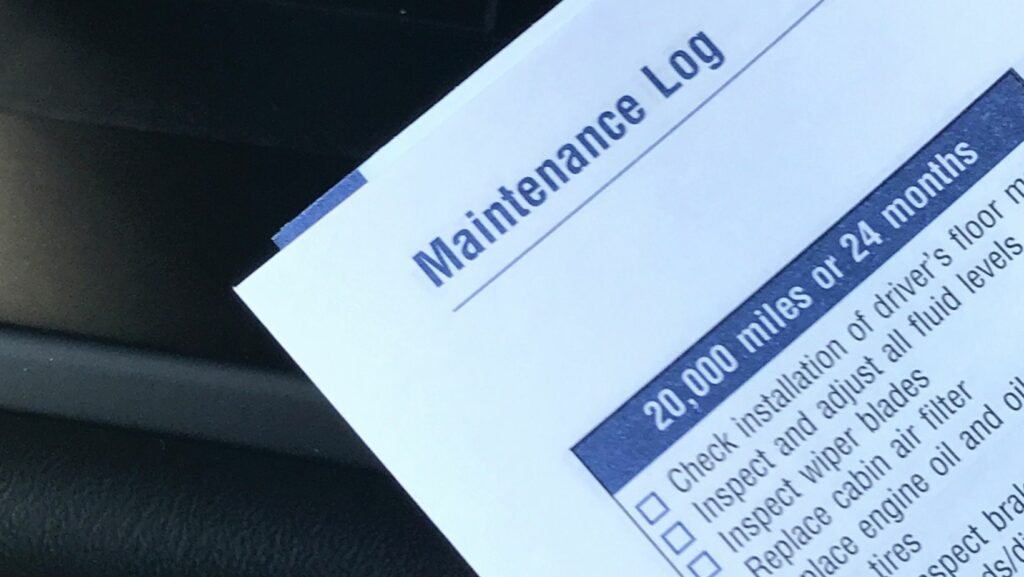Car Maintenance Log
- Essential for Vehicle Care: A car maintenance log is crucial for tracking all services performed; it enhances vehicle performance and extends lifespan.
- Accountability and Cost Savings: Establishing a maintenance log helps ensure timely services, preventing costly repairs and allowing for informed cost management.
- Comprehensive Record-Keeping: Key components to log include date of service, mileage, type of service, parts replaced, and costs to maintain an organized and informative history.
- Utilize Technology: Leveraging digital apps, spreadsheets, or online platforms simplifies logging and ensures easy accessibility to records, reminders, and analysis.
- Avoid Common Mistakes: Regularly update the log with accurate information and avoid neglecting entries to maintain its effectiveness and reliability for future reference.
- Boost Resale Value: A detailed maintenance log can significantly enhance a vehicle’s resale value by demonstrating diligent upkeep to potential buyers.
Keeping a car maintenance log is essential for every vehicle owner. It’s not just about tracking oil changes or tire rotations; it’s a comprehensive record that helps ensure a car runs smoothly and efficiently. A well-maintained vehicle not only enhances safety but also boosts resale value, making it a smart investment for any driver.
In today’s fast-paced world, staying organized can be challenging. A maintenance log simplifies the process, providing a clear overview of all services performed. From routine check-ups to unexpected repairs, having this information at hand can save time and money in the long run. Understanding the importance of a car maintenance log can empower drivers to take control of their vehicle’s health and longevity.
Understanding Car Maintenance Logs
A car maintenance log is essential for every vehicle owner. It provides an organized record of all services performed, ensuring optimal vehicle performance and longevity.
Importance of Maintaining a Log
Maintaining a car maintenance log helps establish accountability for vehicle care. Owners can track service intervals, ensuring timely inspections and replacements. A detailed log also assists in identifying recurring issues, allowing for preventative measures. Moreover, comprehensive records can enhance a vehicle’s resale value by demonstrating diligent upkeep to potential buyers.
- Enhanced Organization: Logbooks provide clear records of services performed, streamlining the management of vehicle maintenance.
- Cost Savings: Timely maintenance can prevent costly repairs, leading to overall cost savings for owners.
- Informed Decisions: Owners can make informed decisions regarding service providers and parts based on historical data.
- Warranty Compliance: A thorough log fulfills warranty requirements by documenting regular maintenance and inspections.
- Safety Assurance: Regularly logged maintenance tasks contribute to overall vehicle safety, ensuring all critical components function properly.
Key Components of a Car Maintenance Log
A comprehensive car maintenance log includes crucial details that support effective vehicle management. Proper record-keeping enhances performance and safety while maximizing the car’s lifespan and resale value.
Essential Information to Record
- Date of Service: Keeping a chronological record of services aids in tracking maintenance history.
- Mileage: Noting the vehicle’s mileage at each service provides insight into usage patterns and service intervals.
- Service Type: Documenting specific services such as oil changes, tire rotations, and brake inspections enables owners to manage routine tasks.
- Parts Replaced: Recording parts replaced, like tires or batteries, helps track wear and tear.
- Service Provider: Maintaining a record of where the service was performed allows for easier follow-up and continuity of care.
- Costs: Including the cost of each service aids in budget management and evaluating the overall expense of vehicle maintenance.
- Next Service Due: Indicating the recommended date for the next service helps in timely maintenance, preventing missed appointments.
- Digital Logs: Using software or mobile apps streamlines record-keeping with features such as reminders and automated mileage tracking.
- Spreadsheets: Creating a digital spreadsheet allows for easy customization, organization, and quick access to information.
- Printed Logs: Maintaining a physical logbook offers a tangible option for those who prefer paper records, ensuring easy reference during appointments.
- Service Booklets: Using manufacturer service booklets provides a structured format recommended by car manufacturers, often aligning with warranty requirements.
Tips for Effective Car Maintenance Logging
Effective car maintenance logging enhances vehicle health and extends lifespan. Implementing best practices and utilizing technology simplifies tracking and organizing maintenance records.
Best Practices for Tracking Maintenance
- Record Every Service: Document all maintenance activities, including routine services and repairs.
- Include Detailed Descriptions: Provide clear descriptions of each service performed, including specific parts and fluids used.
- Document Dates and Mileage: Note the exact date and mileage for each entry to track service intervals accurately.
- Store Receipts: Keep receipts for services and parts to maintain cost records and validate warranty claims.
- Use a Consistent Format: Adopt a standardized format for entries to make it easier to locate past records.
- Review Regularly: Check your log frequently to assess upcoming services and prepare for maintenance needs.
- Digital Apps: Use mobile apps designed for vehicle maintenance logging, allowing for easy access and automated reminders.
- Spreadsheets: Create a custom spreadsheet for flexibility and control over the log’s layout and data organization.
- Online Platforms: Consider online vehicle management tools that offer features like expense tracking and service history analysis.
- Photo Documentation: Take photos of major repairs or changes for visual reference alongside written records.
- Sync with Calendar: Integrate reminders into calendar apps for scheduled maintenance tasks, enhancing timeliness.
Common Mistakes to Avoid
Maintaining a thorough car maintenance log requires attention to detail. Avoiding common pitfalls helps ensure the log remains accurate and useful.
Inaccurate Record Keeping and Neglecting Regular Updates
 Inaccurate record keeping decreases the log’s effectiveness. Mistakes often occur due to unclear descriptions or missing entries. To prevent this, ensure all services include specific details like the service type, parts replaced, and provider information. Provide accurate dates and mileage for every entry. Regularly cross-reference these logs with receipts to catch discrepancies quickly. This practice not only preserves the integrity of the log but also supports warranty claims and potential resale value.
Inaccurate record keeping decreases the log’s effectiveness. Mistakes often occur due to unclear descriptions or missing entries. To prevent this, ensure all services include specific details like the service type, parts replaced, and provider information. Provide accurate dates and mileage for every entry. Regularly cross-reference these logs with receipts to catch discrepancies quickly. This practice not only preserves the integrity of the log but also supports warranty claims and potential resale value.
Neglecting regular updates leads to incomplete information that hinders maintenance efforts. Many vehicle owners forget to log routine services promptly. To combat this, create a habit of updating the log right after any service. Set reminders or notifications through calendar apps to prompt updates post-service. Regular reviews of the log foster awareness of upcoming services and provide insight into vehicle performance trends. This helps catch any recurring issues early and promotes proactive maintenance.
Safer Driving Experience
Maintaining a car maintenance log is vital for every vehicle owner. It not only tracks essential services but also enhances the overall health and safety of the vehicle. By keeping detailed records, owners can make informed decisions about maintenance and repairs, ultimately saving money and increasing resale value.
Utilizing various logging methods allows for flexibility and convenience, ensuring that vital information is always at hand. Regular updates and reviews of the log promote proactive care, helping to prevent issues before they arise. Adopting these best practices empowers drivers to take control of their vehicle’s maintenance journey, leading to a smoother and safer driving experience.

